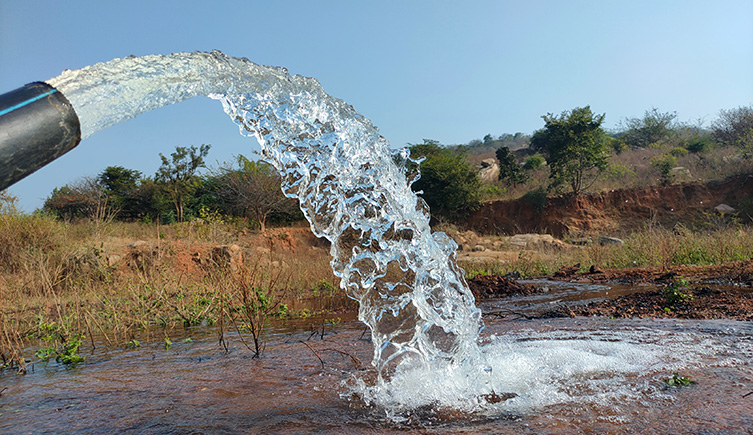Wells, streams and springs are in danger of going dry.
Water levels in as many as a third of the world’s aquifers are declining faster now than they did 40 years ago as we take water out of the ground faster than it can be replaced.

When groundwater levels sink beneath the bottom of a well, then the well runs dry. Image © astudio/Shutterstock.
Wells, streams and springs are in danger of going dry.
Water levels in as many as a third of the world’s aquifers are declining faster now than they did 40 years ago as we take water out of the ground faster than it can be replaced.
Our thirst for ever more water is putting supplies under pressure.
New research, published in the journal Nature, reveals that underground stores of water known as aquifers are under threat. As climate change reduces levels of rainfall in dry areas, there’s increasing pressure to take more water out of the ground for drinking and irrigation.
As a result, we’re in danger of drinking some wells dry. Water levels are declining in almost half of the 170,000 studied wells, with a third of aquifers declining faster now than in 1980.
Dr Scott Jasechko, the lead author of the research, says, ‘Our finding that the rate of groundwater-level decline is speeding up in so many aquifers is worrying. In many areas, groundwater wells which are used to supply billions of people with drinking water, are already running dry.’
‘Groundwater levels are so low in some aquifers that they are nearing an effective “bottom”, and when this happens, even those who can afford to drill a new and deeper well are out of luck.’
While the study found cause for concern, it’s not all bad news. The researchers show that if we can turn down the taps and use water more effectively, aquifers can recover.

The vast majority of groundwater is extracted for irrigating farms. Image © Celipuram Gopichander/Shutterstock.
Earth is a planet defined by its water. From its oceans to its lakes and rivers, water has shaped not just the world’s geography, but also the development of life itself.
While much of this water is visible, a lot of it is also found under our feet. After soaking into the ground, water gradually drains down into permeable rocks and sediment, before slowly returning to the surface over hundreds or thousands of years.
We can speed up this process using wells bored down into the aquifers, allowing us to take water for drinking or irrigation. Normally, the water we take from surface aquifers would gradually be replaced as rain or snowmelt enters the ground.
However, over the past century this changed. As human populations increased, the demand for food and water meant more wells were driven into the ground. Meanwhile, the expansion of our cities, with their paving and tarmac, means it’s more difficult for water to get into the ground.
This has stretched the ability of aquifers to top themselves up again, causing groundwater levels to fall. The researchers found that groundwater levels in around a third of aquifers dropped by at least 10 centimetres a year, with 12% of aquifers seeing an annual fall of more than half a metre.
But some are declining even faster. Groundwater levels at the Cingla-Cuchillo aquifer in Spain, for example, are falling by an average of 1.6 metres a year. With around three quarters of Europe relying on aquifers for their drinking water, this is putting supplies under threat.
It’s also having an impact on the wildlife which live in the world’s aquifers. We’re altering the habitat of subterranean animals like the dragon snakeheads, putting the survival of these unique species at risk.
In addition to that, as groundwater is extracted it causes the soil to become more compact, which over time can lead to subsidence.
One of the most extreme examples of this process is in California’s San Joaquin Valley in California, where the ground level sunk by nine metres between the 1920s and 1970s. Changes in the structure of the soil mean that this will probably never be reversed.

Improving groundwater monitoring globally will help to better understand how levels are changing, and regulating the extraction of water. Image © Scott Jasechko.
Avoiding the most damaging aspects of groundwater declines is as simple as using less water. This can allow aquifers to recover.
In the Thai capital of Bangkok, for instance, the introduction of pumping fees and the licensing of wells is credited with reversing the decline of its aquifer. The Bangkok basin is one of around 16% of aquifers where levels of groundwater are rising, with another fifth declining more slowly than they were in the 1980s.
But this process of recovery is a long one, and is much slower than draining an aquifer. Only around 6% of aquifers are recovering at more than 10 centimetres a year, and just 1% over 50.
Instead, some regions are turning to a process known as managed aquifer recharge, where water is injected back into the ground. In the Avra Valley in Arizona, for instance, groundwater levels are at their highest in more than 40 years after water from the Colorado River was diverted.
However, the Colorado River is already under pressure from water extraction, with so much being taken that it rarely reaches the sea. In this case, managed aquifer recharge risks just moving the problem from one area to another.
This makes it important to reduce water use in other ways. Changes in farming will be an important part of this, as around 70% of groundwater is used for farm irrigation.
This could involve moving away from water-intensive crops like cotton, which needs thousands of litres of water to produce just one kilogramme. Storing rainwater will also help with this, reducing the need for groundwater to be extracted.
Aside from farms, it’s also important to remove barriers to naturally recharging aquifers. Designing urban areas with more green spaces and porous surfaces will help more water to get through to the soil, ensuring groundwater levels can recover.
While these steps could put aquifers on a path to recovery, the researchers say that there’s still a lot of work needed to understand the problem, let alone solve it.
Dr Mohammad Shamsudduha, a co-author of the research, says, ‘This work is just the beginning, as we continue to collate monitoring data from other parts of the world. We hope this work will inspire researchers from around the world to come forward with additional information, and provide impetus for authorities to better monitor groundwater levels.’

We're working towards a future where both people and the planet thrive.
Hear from scientists studying human impact and change in the natural world.
Don't miss a thing
Receive email updates about our news, science, exhibitions, events, products, services and fundraising activities. We may occasionally include third-party content from our corporate partners and other museums. We will not share your personal details with these third parties. You must be over the age of 13. Privacy notice.
Follow us on social media